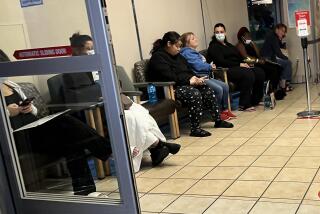Same hospitals but worse outcomes for Black patients than white ones

- Share via
Black patients are significantly more likely to suffer dangerous bleeding, infections and other serious problems related to surgical procedures than are white patients treated in the same hospital, according to a new analysis from the nonprofit Urban Institute.
The analysis, funded by the Robert Wood Johnson Foundation, builds on earlier research showing that Black patients are more likely than white ones to endure injuries and acquire illnesses in the hospital.
A previous analysis from the Urban Institute found that part of the reason for that gap is that Black patients are less likely to be admitted to “high-quality” hospitals than white patients, based on key measures meant to gauge patient care.
But the new report found that even when they are going to the same hospitals, Black patients are more likely to suffer illnesses or injuries tied to surgical procedures, including hemorrhages during the surgical process and sepsis following an operation, than white patients of the same gender and age group.
“Even when admitted to the same hospital, Black patients experience higher rates of hospital-acquired injuries or illnesses occurring during or shortly after surgical procedures relative to white patients,” the analysis concluded.
That troubling pattern persisted even when researchers compared Black and white patients with similar kinds of insurance coverage, when they focused specifically on patients covered by Medicare, and when they limited their analysis to hospitals with a higher percentage of Black patients, which could theoretically be more adept at rooting out racial bias.
And the analysis found that it didn’t make much difference whether the hospitals had more or less resources, as gauged by their share of patients with private insurance.
“It’s disheartening,” said Anuj Gangopadhyaya, a senior research associate in the Health Policy Center at the Urban Institute who authored the report. There are “clearly some effects of structural racism ... that are not isolated in healthcare, but they’re clearly prevalent and persistent across all kinds of comparisons.”
Closing racial gaps in patient care will require changing the way that healthcare is provided within each hospital, not just changing who goes to which hospital, the report concluded.
“You’re going to have to do some work within institutions,” Gangopadhyaya said.
The Urban Institute analysis examined hospital discharge records from roughly half of states across the country — not including California — as of four years ago. The information, drawn from Agency for Healthcare Research and Quality databases, included complete records for discharges from more than 2,300 hospitals, according to the report.
The analysis looked at nearly a dozen measures of patient safety, including “general patient safety indicators” tied to a broad range of hospital discharges, such as how frequently patients got infections related to catheters, or pressure ulcers from remaining in one position too long, as well as injuries and illnesses specifically related to surgical procedures.
Such measures are used by healthcare researchers as a way to zero in on problems associated with faulty care in hospitals, rather than the ailments that patients have when they walk in the door.
“If you get a sepsis infection from an operation, or a catheter infection, these are things that shouldn’t have happened to you,” Gangopadhyaya said. He added that many hospitals have protocols to “virtually eliminate these kinds of things from occurring” and they are seen as “pretty objective quality-of-care measures.”
The report found that the evidence was mixed on whether Black patients had worse results for the “general patient safety indicators” than white patients in the same hospital.
For instance, the analysis found that Black patients were more likely to get catheter-related infections than white patients, but white patients were more likely to have falls in the hospital that caused hip fractures, when comparing patients of the same gender and age group in the same hospital.
But the results were clearly worse for Black patients when it came to ailments related to operations, the analysis found. Black patients had worse rates for all seven of the safety indicators related to surgery, and the rates were “clinically large and statistically significant” for four of those measures: hemorrhages and serious bruising due to blood vessel damage; respiratory failure after an operation; blood clot-related problems such as pulmonary embolism or deep vein thrombosis; and sepsis after surgery.
For instance, Black patients had a 27% higher rate than white patients of the same gender and age group, at the same hospital, of having sepsis after an operation, the analysis found. They also had a 30% higher rate of pulmonary embolism or deep vein thrombosis during the surgical process, according to the report.
Gangopadhyaya said it’s “hard to think about where to start” in addressing the issue.
His report offered up several ideas, including penalties in Medicare reimbursements for hospitals that have such racial gaps; tying some federal funding for state Medicaid programs to measures of racial disparities in patient safety; and periodic auditing of whether care is standardized across patient groups within hospitals.
More to Read
Sign up for Essential California
The most important California stories and recommendations in your inbox every morning.
You may occasionally receive promotional content from the Los Angeles Times.











